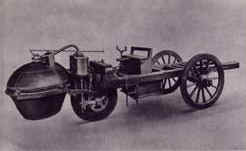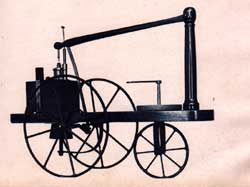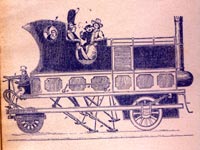|
History
Nicolas
Joseph Cugnot was the first man on earth to drive a
self propelled road vehicle.Cugnot , an army engineer , designed his
steam carriage for hauling field artillery. Constructed in 1769 by a
man named Brezin. The Kings Minister of war was apparently
not too satisfied with Brezin's first machine, asked him to build a
second one. Two years later in 1771 Brezin's second machine finally
saw the light of day. French politics during the seven years of war,
prevented the second machine from being run. But reports say
that the first machine that was driven by Cugnot was capable of
carrying 4 passengers at a maximum of 6 miles/hour and required to
boil the water once every 15 minutes. Cugnot was not only the
first man to drive a self propelled vehicle but also the first man
to knock it over a wall.


Cugnot's Self Propelled
Vehicle
Driving the vehicle through a Wall
In the early 1700s' steam power began to change the world. The
industrial revolution taught the world to harness steam as an
extremely purposeful energy. But though the experiment with the
first motorized vehicle began in France, it wasn't France that would
lead the way to this new mechanical revolution, but England.
Certainly there had been attempts by the earlier monarchy to
experiment with self driven carriages. Crazy European kings would
often build horse less carriages and put helpless citizens to work
as a self propelled vehicle.
In 1784, in Redruth , a village in Cornwall, William Murdock built a
small three wheeled no passenger carrying model which ran away from
him after dark throwing out sparks. An event which went down
in history as being the first self propelled vehicle to frighten a
pedestrian. But Murdock did not continue his experiments for long.
|
William Murdock's Self propelled vehicle

|
About the
same time, Richard Trevithick , another English engineer, was also
working on the same model. A scaled down model was the first
attempt. His experiment was so successful that Richard finally
decided to start working on an actual model. He was joined by his
cousin in the attempt and they both together constructed a full
scale model. On Christmas eve , 1801 , they decided to test their
new self propelled vehicle. Describing the event, a witness to the
same, "It can run faster than any man can walk and can carry
eight people."
Though the development was successful, nobody came forward to
finance the project. Hence the project was scrapped and the boiler
was sold to a man who used it to power his mill.
|
|
In 1805 in Newport USA, Oliver Evans designed a amphibious steam
propelled motor. Seldom that can be called a car. It weighed 20 tons
and was fitted with digging devices, chain buckets and paddles to
move it through water. But still it was a self propelled motor and a
biological ancestor of today's car.
People in
places as far as Hartford, Connecticut, Prague, Halifax, Nova Scotia
were building steam carriages. But it was in England that saw a
sudden boom of steam powered machinery the need for steam powered
and mechanical transportation that arise because of Napoleonic wars.
With more machines meant better roads. Two geniuses Telford and
Macadom revolutionized road building methods and within a short time
built beautiful roads for coaching across England. By 1820 it seemed
every engineer in England had taken to build steam powered coaches,
not for individual ownership but to carry paying passengers.
James Anderson, Scott Russell, Maceroni Squire and the like
were the engineers at work. But it was Gordon who convinced that
mere wheels to push a carriage was a more impractical form of
mechanical locomotion. He designed a carriage with six steam powered
legs and feet to stand. In 1827, the famous Goldsworthy Gurney,
whose steam buses were most successful also had similar legs and
feet. It could carry 21 passengers, had a water tube boiler and was
fitted with separators to ensure dry steam to the cylinder. If
worked efficiently it could be seen chuffing at 15miles/hour in the
streets of London. |
|
Goldsworthy
Gurneys Steam Bus

|
The paid
coaches brought about a new era. The era of democracy of the
automobile. The public transport can always be given the credit of
this new form of democracy. This was a place where discrimination
was seen at its least. A merchant or banker could be sitting next to
a baker or butcher. But at the same time the passengers had to bear
the wrath of the crowd comprising mainly of agricultural laborers
who saw this new revolution as a hindrance in their interests.
"Down with Machinery" and they set upon the carriage and
its occupants as if the stone age boilers, unstable steering,
squeaky wheels and laughable brakes were not enough to scare the
already horrified passengers. |
|
Nor were the
steam carriages blameless either, they blew sparks, made eerie
noises at night that would send a chill through the people
living around and in one case with Hancock's machine, the machine
had a track door through ashes or if required the entire fire could
be deposited on the road ,right in the middle of the road and what
with the great Goldsworthy Gurney's machine throwing sparks, smoke,
making hissing noises at every interval as the shaft gave way to
excess steam and a few pairs of steam powered legs and feet. It felt
like a giant centipede walking aimlessly looking for an evening
hunt.
|
|
Hancock's Carriage

|
The assistant
engineer or whatever he was called mostly had to satisfy himself at
the back of the vehical, in the company of boiler, red
hot coal, leaping chains and coke. Greasing the machinery with a
brush dipped in palm oil and checking the safety valve. Walter
Hancock, the builder of steam carriages with surprising names like Infant,
Autopsy, Automaton, Era and the like ran carriages between city
Moorgate and Paddington carrying in all 4000 passengers. His steam
carriages were a little different from the other carriages.
Hancock's carriage used 200 pounds per square inch of pressure
instead of the normal 50 pounds per square inch, in the boiler. It
also invited trouble.
|
|
In one such case in 1832, the attendant had fastened the safety
valve while the coach was standing. Unfortunately the steam wasn't
used as fast as it was made, eventually bursting the boiler. Another
such mishap was recorded in 1834 when one of Scott Russell's machine
running between Glasgow and Paisley, burst its boiler killing three
people.
Current
Article
|
|
|
 |
|
Site
best viewed in 800 X 600 screen resolution
Disclaimer
Copyright © 2K [Autosmobilis] All rights reserved.
 |